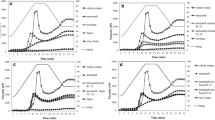Abstract
Pigeonpea flour was substituted at levels of 0, 5, 10, 15,20, 25% to wheat flour and whole wheat meal for bread andChapatti making, respectively. Blends were prepared up to50% for cookie making. Increasing levels of pigeonpeas inthe blends significantly increased the protein and mineralcontent of the baked products. The bread from 10%pigeonpea flour blend with 2–3% vital gluten and 0.5%SSL had high loaf volume and loaf quality. Blends containing 15% pigeonpea flour were acceptable for Chapatti and 30% pigeonpea flour with 0.25% SSL wereacceptable for cookie making.
Similar content being viewed by others
References
Sheheta NA, Fryer BA (1970) Effect on protein quality of supplementing wheat flour with chickpea flour. Cereal Chem 47: 663–670.
Parpia HAB (1969) Protein foods of India based on cereals, legumes and oilseed meals. In Max Milner (ed), Protein enriched cereal foods for world needs. St Paul, MN: American Association of Cereal Chemists, pp 129–139.
Tsen CC, Hoover WJ (1973) High protein bread from wheat flour fortified with full fat soy flour. Cereal Chem 50: 7–16.
Marnett LF, Tenney RJ, Berry VD (1978) Methods for producing soy-fortified breads.Cereal Sci Today 18: 38–43, 50.
Kailasapathy K, Perera PAG, MacNeil JH (1985) Improved nutritional value in wheat bread by fortification with full-fat winged bean flour. J Food Sci 50: 1693–1696, 1702.
Serna-Saldivar SO, Lopez-Ahumada G, Ortega-Ramirez R, Abril-Dominguez R (1988) Effect of sodium stearoyl-2-lactylate on the rheological and baking properties of wheat bread with defatted soybean and sesame meal. J Food Sci 53: 212, 214, 230.
Singh N, Harinder K, Sekhon KS, Kaur B (1991) Studies on the improvement of functional and baking properties of wheat-chickpea flour blends. J Food Process Preser 15: 391–402.
Annual Report (1985) ICRISAT Patancheru, India, pp 79.
Gayle PE, Knight EM, Adkins JS, Herland BF (1986) Nutritional and organoleptic evaluation of wheat breads with pigeonpea (Cajanus cajan) flour. Cereal Chem 63: 136–138.
AACC (1988) Approved Methods, 8th edn. St Paul, MN: American Association of Cereal Chemists.
Piper CS (1950) Soil and Plant Analysis. New York: Inter Science Publication.
AOAC (1980) Official Methods of Analysis, 13th edn. Washington, DC: Association of Official Analytical Chemists.
Fisher (1971) Modern Food Analysis. Washington, DC: Freeman and Company.
Irvine GN, McMullan ME (1960) The 'remix' baking test. Cereal Chem 37: 603–613.
Haridas Rao P, Leelavathi K, Shurpalekar SR (1986) Test baking of chapatti-Development of a method. Cereal Chem 63: 297–303.
Pomeranz Y, Shogren MD, Finney KF (1969) Improving bread making properties with glycolipids II. Improving various protein-enriched products. Cereal Chem 46: 512–518.
Tsen CC, Peters EM, Schaffer T, Hoover WJ (1973) High protein cookies. I. Effect of soy fortification and surfactants. Baker's Dig 47: 34, 36–39.
Bourne MC, Moyer JC, Hand DB (1966) Measurement of food texture by a universal testing machine. Food Technol 20: 522–526.
Larmond E (1970) Methods for sensory evaluation of food. Canada Dep of Agri Pubn, 1284.
Steel RGD, Torrie JH (1960) Principles and Procedures of Statistics,New York: McGraw Hill.
Gopalan C, Ramasastri BV, Balasubramanian SC (1982) Nutritive value of Indian foods. Hyderabad, India: NIN, ICMR.
Alok-Shah, Chauhan GS, Verma NS (1986) Effect of enzyme active soy flour and roasted soy flour on rheological and baking characteristics of wheat flour. J Food Sci Technol 23: 257–260.
Kissell LT, Yamazaki WT (1975) Protein enrichment of cookie flours with wheat gluten and soy flour derivatives. Cereal Chem 52: 638–649.
Author information
Authors and Affiliations
Rights and permissions
About this article
Cite this article
Harinder, K., Kaur, B. & Sharma, S. Studies on the baking properties of wheat: Pigeonpea flour blends. Plant Foods Hum Nutr 54, 217–226 (1999). https://doi.org/10.1023/A:1008158208549
Issue Date:
DOI: https://doi.org/10.1023/A:1008158208549




